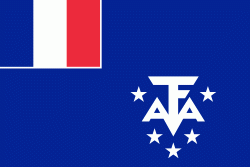Île Amsterdam (Îles Saint-Paul et Nouvelle-Amsterdam)
Île Amsterdam, also known as Amsterdam Island and New Amsterdam (Nouvelle-Amsterdam), is an island of the French Southern and Antarctic Lands in the southern Indian Ocean that together with neighbouring Île Saint-Paul 90 km to the south forms one of the five districts of the territory.
The island is roughly equidistant to the land masses of Madagascar, Australia, and Antarctica – as well as the British Indian Ocean Territory and the Cocos (Keeling) Islands (about 3200 km from each).
The research station at Martin-de-Viviès, first called Camp Heurtin and then La Roche Godon, is the only settlement on the island and is the seasonal home to about thirty researchers and staff studying biology, meteorology, and geomagnetics.
The first person known to have sighted the island was the Spanish explorer Juan Sebastián de Elcano, on 18 March 1522, during his circumnavigation of the world. Elcano did not give the island a name. On 17 June 1633, Dutch mariner Anthonie van Diemen sighted the island, and named it after his ship, Nieuw Amsterdam. The first recorded landing on the island occurred in December 1696, led by the Dutch explorer Willem de Vlamingh.
French mariner Pierre François Péron wrote that he was marooned on the island between 1792 and 1795. Péron's Memoires, in which he describes his experiences, were published in a limited edition, now an expensive collectors' item. However, Île Amsterdam and Île Saint-Paul were often confused at the time, and Péron may have been marooned on Saint-Paul.
Sealers are said to have landed on the island, for the first time, in 1789. Between that date and 1876, 47 sealing vessels are recorded at the island, 9 of which were wrecked. Relics of the sealing era can still be found.
The island was a stop on the Macartney Mission during its voyage to China in 1793.
On 11 October 1833, the British barque Lady Munro was wrecked at the island. Of the 97 persons aboard, 21 survivors were picked up two weeks later by a US sealing schooner, General Jackson.
John Balleny in command of the exploration and sealing vessel Eliza Scott (154 tons) visited the island in November 1838 in search of seals. He returned with a few fish and reported having seen the remains of a hut and the carcass of a whale.
The islands of Île Amsterdam and Île Saint-Paul were first claimed by France in June 1843. A decree of 8 June 1843 mandated the Polish captain Adam Mieroslawski to take into possession and administer in the name of France both islands. The decree as well as the ship's log from the Olympe ship from 1 and 3 July 1843, stating that the islands had been taken into possession by Mieroslawski, are still preserved. However, the French government renounced its possession of the islands in 1853.
The island is roughly equidistant to the land masses of Madagascar, Australia, and Antarctica – as well as the British Indian Ocean Territory and the Cocos (Keeling) Islands (about 3200 km from each).
The research station at Martin-de-Viviès, first called Camp Heurtin and then La Roche Godon, is the only settlement on the island and is the seasonal home to about thirty researchers and staff studying biology, meteorology, and geomagnetics.
The first person known to have sighted the island was the Spanish explorer Juan Sebastián de Elcano, on 18 March 1522, during his circumnavigation of the world. Elcano did not give the island a name. On 17 June 1633, Dutch mariner Anthonie van Diemen sighted the island, and named it after his ship, Nieuw Amsterdam. The first recorded landing on the island occurred in December 1696, led by the Dutch explorer Willem de Vlamingh.
French mariner Pierre François Péron wrote that he was marooned on the island between 1792 and 1795. Péron's Memoires, in which he describes his experiences, were published in a limited edition, now an expensive collectors' item. However, Île Amsterdam and Île Saint-Paul were often confused at the time, and Péron may have been marooned on Saint-Paul.
Sealers are said to have landed on the island, for the first time, in 1789. Between that date and 1876, 47 sealing vessels are recorded at the island, 9 of which were wrecked. Relics of the sealing era can still be found.
The island was a stop on the Macartney Mission during its voyage to China in 1793.
On 11 October 1833, the British barque Lady Munro was wrecked at the island. Of the 97 persons aboard, 21 survivors were picked up two weeks later by a US sealing schooner, General Jackson.
John Balleny in command of the exploration and sealing vessel Eliza Scott (154 tons) visited the island in November 1838 in search of seals. He returned with a few fish and reported having seen the remains of a hut and the carcass of a whale.
The islands of Île Amsterdam and Île Saint-Paul were first claimed by France in June 1843. A decree of 8 June 1843 mandated the Polish captain Adam Mieroslawski to take into possession and administer in the name of France both islands. The decree as well as the ship's log from the Olympe ship from 1 and 3 July 1843, stating that the islands had been taken into possession by Mieroslawski, are still preserved. However, the French government renounced its possession of the islands in 1853.
Map - Île Amsterdam (Îles Saint-Paul et Nouvelle-Amsterdam)
Map
Country - French_Southern_and_Antarctic_Lands
 |
 |
* 1) Adélie Land (Terre Adélie), the French claim on the continent of Antarctica.
Currency / Language
| ISO | Currency | Symbol | Significant figures |
|---|---|---|---|
| EUR | Euro | € | 2 |
| ISO | Language |
|---|---|
| FR | French language |















